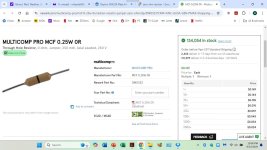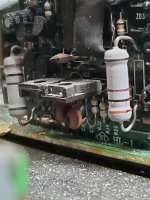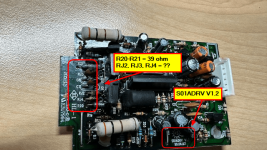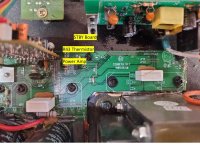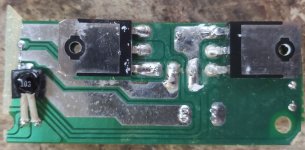5) We were able to get a shot of the bottom of the 2nd stage preamp. RJ2, 3 and 4 are in fact zero Ohm resistors. Note the single black band on the resistor’s body. The second attachment is a catalog cut from Newark, but several vendors sell them. Looks like you will need two 39 Ohm and three zero Ohm resistors. However, the key question remains, “What caused the resistors to burn up?” Most of the time it is a bad transistor or shorted cap. Caps fail short, resistors fail open and transistors can fail open or short. BTW, S01ADRV = Amplifier Driver.
Attachments
Last edited:
You don't need to use zero Ohm resistors in a repair, a jumper will do just fine. They are just (sometimes) more convenient in automatic PCB production.
gustinotetro- Please look at C4. It seems to be bulging . . .
Attachments
Last edited:
Gustinotetro- would you be kind enough to take a shot or two of this board from straight overhead at hi res? Many thanks- EVMan
That is a new one for me. R43 is a nominal 10k0 thermistor. Any other problems? Suggest you check the semi-conductors in zones A1, A2, B1, B2 on the schematic and look for shorts. R43 is part of the protection circuitry. You can try a 10K, 1/2 W resistor and see what happens if you feel lucky. On a good day, this shouldn't be in circuit. Any other symptoms? If R43 is open, does the amp still work? EVMan
Thanks.
The amp still powers on but there is no appreciable output.
I'm a perpetual beginner when it comes to troubleshooting...
By semiconductors do you mean the amp transistors, by check for shorts, is that just a DMM connectivity check between a transistor leg and ground?
The amp still powers on but there is no appreciable output.
I'm a perpetual beginner when it comes to troubleshooting...
By semiconductors do you mean the amp transistors, by check for shorts, is that just a DMM connectivity check between a transistor leg and ground?
Thanks, it's midday, a bit early for wine 🤣
I've done a fairly complete visual inspection, everything looks OK, no bulging caps, no burn marks, all pretty normal.

I've done a fairly complete visual inspection, everything looks OK, no bulging caps, no burn marks, all pretty normal.
I mean the thermistor might not have blown, maybe the legs simply corroded and it fell off.
If you look closely, you should see if the legs are melted, corroded or cut off.
Maybe even a factory "modification"? These amps are known for their bad design, all failing after some time of use. They are build that cheap, PE can replace each of them once and still make money. That has been known for years know.
Maybe even a factory "modification"? These amps are known for their bad design, all failing after some time of use. They are build that cheap, PE can replace each of them once and still make money. That has been known for years know.
Honestly, it looks like the legs have been cut, the amp was salvaged from a 20 y.o. sub, that while in storage (for being faulty), got a bit wet on one edge and puffed up, I wasn't planning to use the amp as I have a spare external amp (Emotiva XPA-100) that I'm going to use when I've built a new enclosure for the woofer. It was just if I could easily fix it that I was interested in doing so, more for the spares bin than anything.
If the Amp is really 20 years old, you have an early model SPA250. These amps are not reliable- I have
been through four them myself and troubleshot a bunch more. If this amplifier is still in working order
(Sans R43), it would be a minor miracle. R43 forms part of the biasing network for Q11/ZD2. NOTE: R43
is a thermistor mounted underneath the board and pressed against the heatsink via a foam pad. It also
interacts with the other protection circuitry. This points to a couple of possibilities: 1) the protect
circuitry went bad or 2) the main amp has a fault and the protect circuitry is holding it off.
If you are knowledgeable in electronics and have some test equipment, it’s time to start testing statically.
Page 6 of this post has a blurb about an “Octopus component tester.” This requires an O’scope with dual
channels, capable of X-Y operation. If you lack the tools, you can always try a friend, audio club or local
high school/college. You will need to test all semiconductor junctions. This is a daunting task with DMM,
but fairly simple with an Octopus. This tester will not give Zener diode breakdown voltage, but it will
show if the junction is intact.
My guess (stress guess) is that something went South inside the amp. Big time. I would be happy to take
a look at it, but two-way shipping from Australia would probably cost more than the amp is worth. On
the upside, it is 5 PM somewhere in the world, so there is no need to feel constrained. Have that glass of
wine.
been through four them myself and troubleshot a bunch more. If this amplifier is still in working order
(Sans R43), it would be a minor miracle. R43 forms part of the biasing network for Q11/ZD2. NOTE: R43
is a thermistor mounted underneath the board and pressed against the heatsink via a foam pad. It also
interacts with the other protection circuitry. This points to a couple of possibilities: 1) the protect
circuitry went bad or 2) the main amp has a fault and the protect circuitry is holding it off.
If you are knowledgeable in electronics and have some test equipment, it’s time to start testing statically.
Page 6 of this post has a blurb about an “Octopus component tester.” This requires an O’scope with dual
channels, capable of X-Y operation. If you lack the tools, you can always try a friend, audio club or local
high school/college. You will need to test all semiconductor junctions. This is a daunting task with DMM,
but fairly simple with an Octopus. This tester will not give Zener diode breakdown voltage, but it will
show if the junction is intact.
My guess (stress guess) is that something went South inside the amp. Big time. I would be happy to take
a look at it, but two-way shipping from Australia would probably cost more than the amp is worth. On
the upside, it is 5 PM somewhere in the world, so there is no need to feel constrained. Have that glass of
wine.
Yup, lol, R43 is intact and mounted on the other side, doh, makes sense for it to be touching the heatsink!
I do have an oscilloscope, it's rarely used and my skills are very beginner.
This will be a fun learning experience for me!
I do have an oscilloscope, it's rarely used and my skills are very beginner.
This will be a fun learning experience for me!
If there is no smoke, you can try applying power in the “Always on” mode. Then measure the voltage
across R40 and R41 to measure +/- 65 Vdc. The voltage across R44 should be around 18 Vdc. Tolerance
should be ten percent. The board labeled “STDBY” generates +12 Vdc for the auto sense circuit. C8
should have 12 volts across it. C8 is a known problem child and it refuses to eat vegemite. While you
have this amp on the bench, you can check that the bleeder and Zener resistors are 3K Ohm, 2 Watt.
Early versions had these resistors at 2.4K and they will burn up at this value. If all voltages are present,
you have a choice to make: 1) Static troubleshooting with a DMM or Octopus (my 1st choice) or 2)
Troubleshoot dynamically with power applied, 100Hz input signal and dummy load. Please let us know
what you find. Good luck- EVMan
across R40 and R41 to measure +/- 65 Vdc. The voltage across R44 should be around 18 Vdc. Tolerance
should be ten percent. The board labeled “STDBY” generates +12 Vdc for the auto sense circuit. C8
should have 12 volts across it. C8 is a known problem child and it refuses to eat vegemite. While you
have this amp on the bench, you can check that the bleeder and Zener resistors are 3K Ohm, 2 Watt.
Early versions had these resistors at 2.4K and they will burn up at this value. If all voltages are present,
you have a choice to make: 1) Static troubleshooting with a DMM or Octopus (my 1st choice) or 2)
Troubleshoot dynamically with power applied, 100Hz input signal and dummy load. Please let us know
what you find. Good luck- EVMan
These cheap plate amps are very unreliable. I've tried so many of them over the years. They're just cheap junk. They would frequently blow output transistors. The heatsink was always undersized for continuous 4 ohm use. Carbon film resistors have no business in a place where they can actually cause a fire.
Back in the early 2000s I was developing a subwoofer to go with some small nearfield monitors I used to build and sell. I ended up with a custom design using bridged parallel LM3886s, which was far more reliable, simpler and sounded as good as or better than any other class AB amp that was being used with a sub.
Now that class D has become so popular and evolved in sound quality, it no longer makes sense using class AB for a sub. My favorite plate amps are made by Speaker Power.
Back in the early 2000s I was developing a subwoofer to go with some small nearfield monitors I used to build and sell. I ended up with a custom design using bridged parallel LM3886s, which was far more reliable, simpler and sounded as good as or better than any other class AB amp that was being used with a sub.
Now that class D has become so popular and evolved in sound quality, it no longer makes sense using class AB for a sub. My favorite plate amps are made by Speaker Power.
- Home
- Loudspeakers
- Subwoofers
- Dayton SPA250 Plate Amplifier repair help
